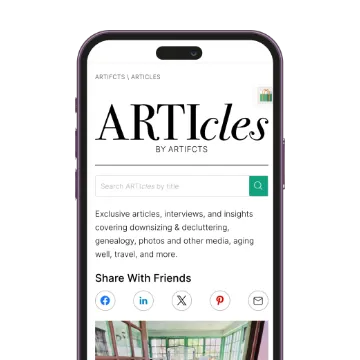When Anthony Bourdain passed away, he left behind an estate of objects, objects surely with stories. Or not.
Some stories were no more than, “It belonged to him,” and if you admired his work or his person, maybe that would have been enough to compel you to purchase a piece from his estate auction. Other objects carried the weight of the star and a glimmer of who Anthony Bourdain was in the moment and place when the object became a part of his life. Pieces of his legacy.


Famous or not, the same is true for the objects of your life. Much of what you own you simply own. It decorates your home or maybe serves some functional requirement—why, hello, Chair. But some objects are more than objects, to you. You know where that print hung above your parents’ sofa. That 3000-piece train collection that was a joy for all and chief resident of your uncle's 500 square foot basement. And don’t forget that seemingly random ceramic jar set. You bought those in a small town outside Lake Garda, Italy, during your honeymoon.
Other objects come into your life through others, such as the passing of a relative. These are especially challenging objects. You may not know anything about them other than who gave them to you. Maybe you chose a few items to take from your grandmother’s estate or an item was bequeathed to you and you think you can’t go against your grandmother’s wishes and have to hold onto it.
Objects have histories, people have histories, and it all gets really complicated.
At Artifcts, we simplify and try to alleviate some of the burden stuff can create by making it easy to capture the history, life experiences, and memories behind objects. This holds true whether or not you keep the item.
To understand more about factors to consider when you want to sell an item, we sat down with Lark Mason of Antiques Roadshow fame and who you can often find these days at his New Braunfels, Texas-based auction house Lark Mason Associates. His message was clear: “I wish people understood their own motivations [regarding objects] more. Are they deriving an emotional charge from owning it? Do they want to make money somehow?”
The motivation for selling is vital to Lark Mason Associates because a seller’s motivations can influence whether the sale is a success in the eye of the beholder - What’s the minimum acceptable price? What is the sale timeline? (If you’re in a rush, you may have to forgo some of the value premium in favor of closing the deal.)
So, if you have you decided to sell an item, take Mason’s advice and pause and reflect on your goals and motivations:
-
-
-
- Are you downsizing and must part with some objects?
- Do the objects simply no longer fit your lifestyle or current decor, so you want to sell them and use the proceeds to replace them?
- Do you have legal or financial problems that require you to divest assets?
- Are these inherited and/or you are charged with dispersing the estate? If there’s a will, what does it say to do with proceeds of any sales (e.g. divide among children, philanthropies, other)?
- Are you sure you’re ready to let go? Acknowledge your emotional attachments to the items. Artifct to remember and to maybe share those Artifcts with others who have ties to the items.
-
-
As Mason gently noted, once you let go of an item, its identity is changed for good. Someone will bring the object home to a new environment, display it in a new way, not how your grandmother did. Not with the companion pieces or surrounding bookcase. (Although we see attempts to do so! Check out this Artifct.) Not with her favorite music playing in the background. This means then that “Even those ties to what ‘once was’ get weakened over time—now you have random grouping of objects that have been inherited through lethargy, financial, and emotional connections—and shift,” said Mason.
We know the content of Bourdain’s personal collection moved on to new homes, and to Mason’s point, they likely took on new identities. Maybe the chef’s knife is no longer actively used and sits encased. Or his desk has become a foray table featuring photos of a family Bourdain never met. So it goes for him and for all of us.
But what legacy do you want to leave behind? And how will you make the most of the objects you accumulate as you live your life? Documenting and readying them for sale is one option, and Artifcts is here to help guide and support you if you do.
Happy Artifcting!
###
If you have items you would like to consign or auction through Lark Mason Associates or are in the market for a new piece, visit https://www.larkmasonassociates.com.
© 2022 Artifcts, Inc. All Rights Reserved.




























